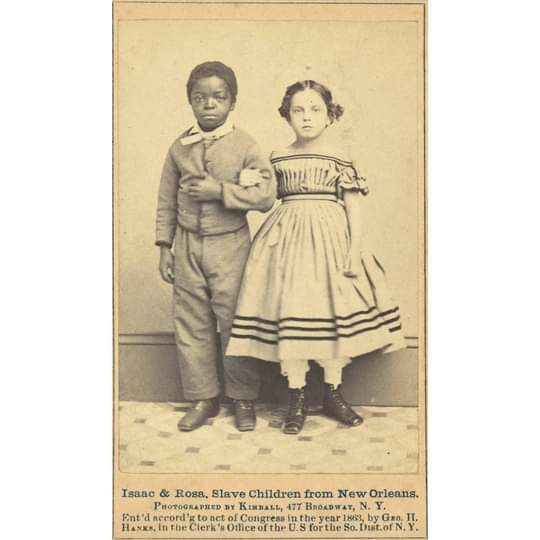Notifications

-
1K Views 0 Comments 0 Likes 0 Reviews

???????????? ???????????????????? ???????? ???????????????????? ???????????? ????????????????, ???????????? ???????????????????????????????????????????? ???????????????????? ???????????????????????????????? ???????????????? ???????????? ????????????????????????????, 1863
With arms linked, and direct their gaze to the contraption in front of them ????. Isaac was eight and Rosa, six.
How two former slave children from Louisiana ended up in a Broadway photographer’s studio in 1863 requires some explanation. For now, it is enough to know that both children had been the property of slaveholders in New Orleans not long before their image was printed on cartes-de-visite (a new format for photography in the mid-nineteenth century, allowing for more than one copy, on individual cards, made cheaply) and offered for sale.
According to an article published in Harper’s Weekly on January 30, 1864, the biography of Isaac and Rosa is summarized as:
Isaac White is a black boy of eight years, but nonetheless intelligent than his whiter companions. He has been in school about seven months, and I venture to say that not one boy in fifty would have made as much improvement in that space of time.
Rosina Downs is not quite seven years old. She is a fair child, with a blonde complexion and silky hair. Her father is in the rebel army. She has one sister as white as herself and three brothers who are darker. Her mother, a bright mulatto, lives in New Orleans in a poor hut and has hard work to support her family.
The sale of their portrait would fund newly established schools for former slaves in southern Louisiana, a region already occupied by the Union army. In act, the Civil War still had its hold on the nation, with death tolls and discontent on the rise. The portrait of Isaac and Rosa, at once charming and provocative, said much about the uncertainties that hung in the air that year.
They would have made an uncommon pair, the black-skinned boy and the white-skinned girl. Although there were many racial taboos in nineteenth-century America, a white girl on the arm of a black boy was surely one of the most scandalous.
That Rosa was a “colored” girl who only looked white – that she toyed with a person’s ability to see blackness at all – only made the pair of them more intriguing. Isaac wore a suit with tie and collar, his cap in hand, and Rosa a dress and cape, full petticoats, and a fancy hat.
Despite their young ages, they stood to pose like a gentleman and lady making an entrance. But that was much the point of the photograph: to anticipate the adults they would become. The portrait “Isaac and Rosa, Emancipated Slave Children from the Free Schools of Louisiana,” was, above all, a picture about the future. Or rather, about the many futures that seemed possible in 1863.
???? Isaac and Rosa, slave children from New Orleans. Photographed by Kimball, 477 Broadway, N. Y. 1863.
#???????????????????????????????????????????????? #???????????????????????????????????????????????????????????????????????????????????????? ???? ✊????
Share this page with your family and friends.